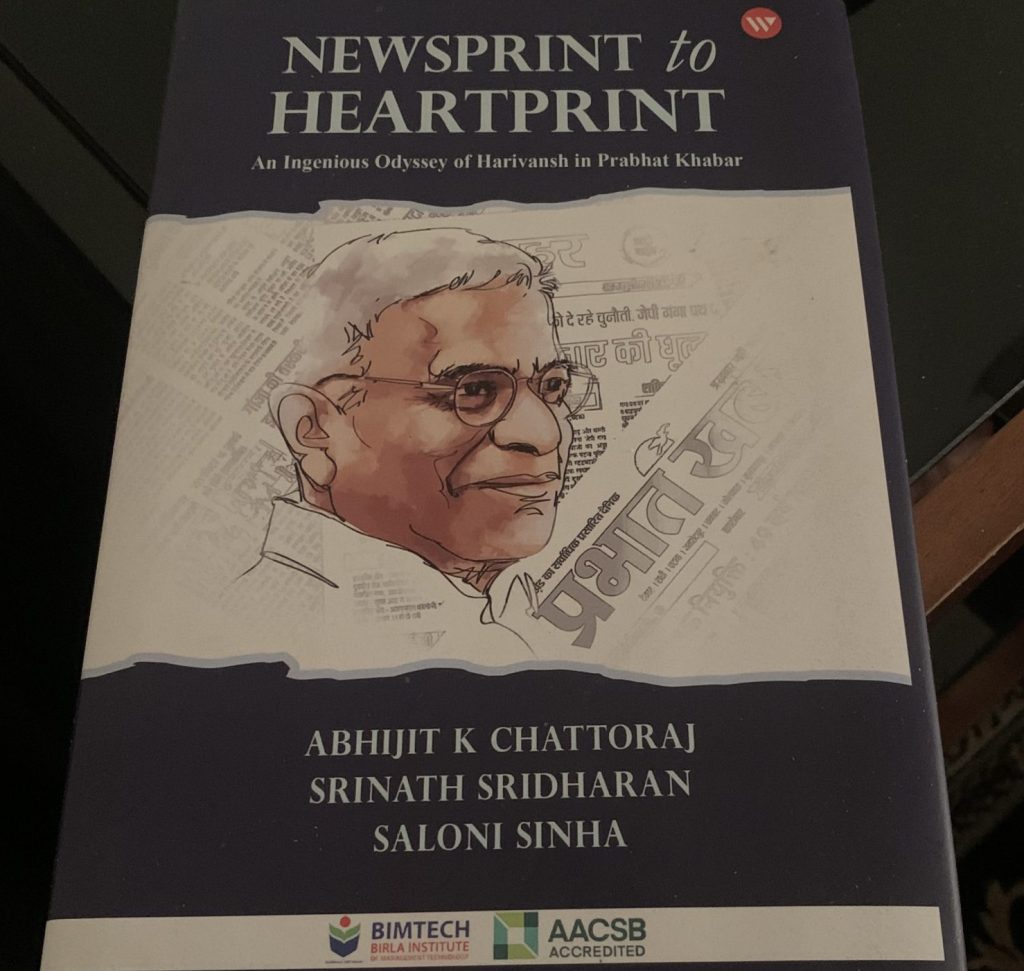The book chronicles the remarkable turnaround story of the Ranchi-based Hindi daily, Prabhat Khabar. Co-authored by Chattoraj, Srinath Sridharan, and Saloni Sinha, it details the vital factors responsible for the resurrection of the once “dying” newspaper under its editor-in-chief Harivansh in Jharkhand, Bihar, West Bengal, and the Hindi-speaking regions of Odisha. A book review by Manoj Prasad

Book: Newsprint to Heartprint: An Ingenious Odyssey of Harivansh in Prabhat Khabar
Authors: Abhijit Chattoraj, Srinath Sridharan and Saloni Sinha
Publishers: Writersgram Publications
Price: Rs 899
Pages: 216
I posted a while back about my aspiration to write my inner geek on Harivansh but failed. Then time passed, and years later, I found Abhijit Chattoraj, Srinath Sridharan, and Saloni Sinha had co-authored a book — ‘Newsprint to Heartprint: An ingenious Odyssey of Harivansh in Prabhat Khabar’.
This 216 -page text covers a remarkable success story of the Ranchi-based Hindi daily, Prabhat Khabar.
First, this book gives full details, including vital factors responsible for the ‘rise’, ‘challenges’ and ‘growth’ of a moribund Hindi daily Prabhat Khabar under its editor-in-chief Harivansh in Jharkhand, Bihar, West Bengal and Hindi belt of Odisha during the penultimate decade of the twentieth century and the first decade of the ongoing millennium.
I think the entire text of this book is specially meant for a serious student of journalism and business management.
The chapter under the heading ‘Revival from the verge of closure’ states a mind-boggling truth. Under the captainship of Harivansh, “Prabhat Khabar had to navigate with many challenges since its inception in 1989…with its circulation falling abysmally low to 400-500 copies…”
Interestingly, among the reasons considered responsible for the fall of this Hindi daily as a “dying newspaper” was the “Bhoot”(evil spirit). The Pundit’s assertion was centred around the plot of land where the headquarter office of Prabhat Khabar, Kokar Industrial Area, Ranchi, was located right outside the wall of a graveyard. While the graveyard continued to exit, ‘Bhoot’ disappeared and Prabhat Khabar under Harivansh grew and climbed up rapidly in the form of its dozen editions and thousands of readers-cum-subscribers.
The challenges overcome by Harivansh and his team were many. Though Ranchi-based private company Usha Martin Group of Industries owned Prabhat Khabar, which was being edited by Harivansh in 1987-88, a media expert three years later, according to the book (page 29) in 1991 “suggested in writing that Prabhat Khabar should be closed as early as possible as it had no future whatsoever.”
Then, while making monthly payments to editorial and office staff, the owner was not ready to invest, Harivansh was determined to print Prabhat Khabar through “ramshackle Bandhu’s web offset printer.” And he did it.
The next challenge overcome by Harivansh was in the form of a sudden invasion of Delhi and UP-headquartered popular Hindi dailies – Dainik Jagran, Dainik Bhaskar and Hindustan in 2000.
Harivansh’s entrepreneurial side came to the fore when in June 2000, a leading newspaper house in the country engineered an exodus of 33 key persons working in critical positions at Prabhat Khabar to “ensure that the next day’s Prabhat Khabar could not be published.” However, Harivansh mobilised his working staff and incorporated key new staff and ensured that the competitor’s designs were defeated.
Harivansh revamped the news packaging with a distinctive pro-people, pro-Bihar bifurcation, and pro-Jharkhand movement content fix while following the principle of ethical journalism, a feature needed to gain credibility among readers.
He ensured that Prabhat Khabar expressed a resonant voice for the voiceless and highlighted the impact of Naxalite violence and corruption. Using investigative journalism, he played a major role in highlighting multi-billion-rupee fodder scam cases in the 1990s.
(Manoj Prasad is Ex-Columnist of The Indian Express and Founding Editor, JharkhandStateNews.com)












